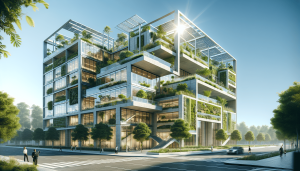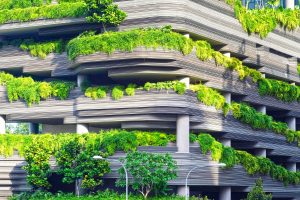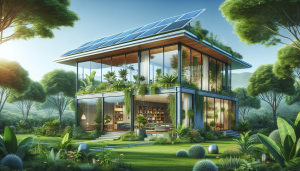In today’s rapidly changing world, it’s becoming increasingly clear that how we build our homes, offices, and public spaces has a profound impact on our environment. In our article, “Why Is Sustainable Architecture Important?” we delve into the reasons why adopting eco-friendly design and construction practices is crucial for the health of our planet and future generations. Sustainable architecture not only reduces our carbon footprint but also makes efficient use of resources, promotes biodiversity, and creates healthier living spaces for us all. Join us as we explore the transformative power of sustainable architecture and its significance in shaping a greener, more sustainable future for everyone. Why do we need sustainable architecture in today’s world? This question leads us to explore the significance of incorporating sustainability into our built environment. As we navigate various challenges like climate change, resource depletion, and increasing urbanization, understanding the importance of sustainable architecture becomes crucial for creating a healthier and more resilient future.
What Is Sustainable Architecture?
Sustainable architecture, also known as green or eco-architecture, focuses on minimizing the negative environmental impact of buildings through efficiency and moderation in the use of materials, energy, and development space. It’s not just about constructing buildings; it’s about designing an entire lifestyle that benefits both us and the planet.
Components of Sustainable Architecture
To achieve sustainability in architecture, several key components need to be addressed:
| Component | Description |
|---|---|
| Energy Efficiency | Utilizing renewable energy sources, improving insulation, and optimizing building designs to reduce energy consumption. |
| Material Efficiency | Using recycled, renewable, and non-toxic materials that have a lower environmental impact. |
| Water Efficiency | Implementing systems to reduce water use and manage wastewater more effectively. |
| Indoor Environmental Quality | Ensuring the indoor environment promotes health and well-being through good air quality, natural light, and non-toxic materials. |
| Sustainable Site Planning | Choosing locations and designs that reduce harm to the environment and complement natural processes. |
The Environmental Impact of Conventional Architecture
Traditional construction practices have often overlooked their environmental impact, leading to numerous harmful effects. Buildings account for a significant portion of global energy use and greenhouse gas emissions. Construction activities consume vast amounts of raw materials, and waste generated from building demolitions adds to our already overburdened landfills.
The Role of Construction in Climate Change
Conventional buildings are major energy guzzlers. They require substantial energy for heating, cooling, lighting, and maintaining. This energy often comes from fossil fuels, which emit greenhouse gases and contribute to global warming. By transitioning to sustainable architecture, we can significantly reduce our carbon footprint.
Economic Benefits of Sustainable Architecture
While sustainable architecture might seem costly during the initial stages, it offers numerous economic advantages over time. Energy-efficient buildings reduce utility bills, and the use of durable and sustainable materials lowers maintenance costs. Moreover, sustainable buildings often have higher property values and occupancy rates.
Long-Term Savings
Investing in sustainable building technologies, like solar panels and energy-efficient HVAC systems, can lead to significant savings on energy and water bills. For example, a building that utilizes passive solar design can drastically cut heating costs by maximizing natural sunlight.
Incentives and Regulations
Many governments offer incentives, such as tax breaks and rebates, for buildings that meet certain green standards. Additionally, as regulations around environmental impact tighten, adhering to sustainable practices can ensure compliance and avoid potential fines and legal issues.
Health and Well-Being Benefits
Sustainable architecture is not just about protecting the environment; it’s also about creating healthier living spaces. Buildings designed with sustainability in mind often feature better ventilation, access to natural light, and the use of non-toxic materials, which collectively enhance the well-being of inhabitants.
Improved Air Quality
Indoor air quality has a significant impact on our health. By incorporating natural ventilation systems and avoiding harmful materials, we can minimize exposure to pollutants and allergens, thereby improving overall health and comfort.
Enhanced Comfort and Productivity
Access to natural light and outdoor views not only makes buildings more appealing but also boosts mood and productivity. Studies have shown that occupants of sustainably designed buildings often report higher satisfaction levels, which can translate to better performance in work environments.
Contribution to Resource Conservation
The responsible use of resources is a fundamental aspect of sustainable architecture. By prioritizing renewable and recycled materials, we can greatly reduce the environmental footprint of buildings. Additionally, sustainable architecture often includes strategies to minimize water usage and promote biodiversity.
Renewable and Recycled Materials
Using materials like bamboo, recycled steel, and reclaimed wood not only reduces waste but also lessens the demand for virgin resources. These materials often have lower embodied energy, meaning less energy is required for their production and transportation.
Water Management
Sustainable buildings often incorporate systems like rainwater harvesting and greywater reuse, which help conserve water and reduce the burden on municipal water supplies. Efficient plumbing fixtures and landscaping designs that utilize native plants can further enhance water savings.
Social and Community Benefits
Sustainable architecture can also foster social sustainability by creating spaces that support community interaction and inclusivity. Designing buildings and neighborhoods with accessibility in mind ensures that they serve all members of society, including those with disabilities.
Promoting Community Interaction
Green spaces, community gardens, and communal areas in and around sustainable buildings can encourage social interaction and foster a sense of community. These features can help mitigate the isolating effects of urban living and contribute to social well-being.
Inclusive Design
Sustainable architecture aims to address the needs of all inhabitants. This includes designing for accessibility and ensuring spaces are adaptable for people of different ages and abilities. Such designs promote equality and enhance the quality of life for everyone.
Technological Advancements in Sustainable Architecture
Innovation and technology play a critical role in advancing sustainable architecture. From smart building systems that optimize energy use to innovative construction materials, technology helps make sustainable design more efficient and effective.
Smart Building Technologies
Smart thermostats, automated lighting systems, and advanced HVAC controls are just a few examples of technologies that can significantly reduce energy consumption. These systems use sensors and algorithms to optimize building performance in real-time, leading to substantial energy savings.
Innovative Materials
Recent advancements have led to the development of materials that offer superior sustainability benefits. For instance, aerogels provide excellent insulation properties, and transparent solar panels can generate energy without compromising natural light.
The Future of Sustainable Architecture
The integration of sustainability in architecture is not just a trend; it’s a necessary evolution of how we approach building and urban design. As we move into the future, the principles of sustainable architecture will likely become the standard, driven by both necessity and innovation.
Emerging Trends
Several emerging trends are set to shape the future of sustainable architecture, including:
| Trend | Description |
|---|---|
| Biophilic Design | Incorporating natural elements into building design to enhance well-being and connectivity with nature. |
| Circular Economy | Designing buildings with materials that can be reused or recycled at the end of their lifecycle. |
| Net-Zero Buildings | Constructing buildings that produce as much energy as they consume over the course of a year. |
| Urban Farming | Integrating food production within urban environments to reduce the carbon footprint of food transportation. |
The Role of Education and Awareness
Increasing awareness about the benefits of sustainable architecture is essential for its widespread adoption. Educational programs, workshops, and campaigns can inform and inspire individuals, professionals, and policymakers to prioritize sustainable practices in construction and design.
Conclusion
In conclusion, sustainable architecture is vital to addressing the environmental, economic, and social challenges we face today. By designing buildings that are energy-efficient, resource-efficient, and healthier for inhabitants, we can create a more sustainable future. The transition towards sustainable architecture requires a collective effort, involving changes in design practices, technological innovations, and increased awareness and education.
We hope this exploration of why sustainable architecture is important encourages us to think more critically about the buildings we live and work in and inspires us to advocate for and support sustainable design solutions in our communities. Together, we can make a significant positive impact on our environment and our quality of life.



